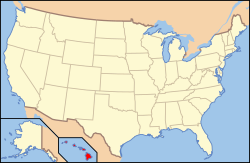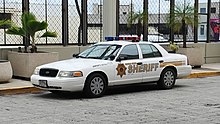Hawaii Department of Law Enforcement
| Hawaii Department of Law Enforcement Hawaiʻi Ka ʻOihana Hoʻokō Kānāwai (Hawaiian) | |
|---|---|
 Seal of Hawaii | |
| Abbreviation | DLE |
| Agency overview | |
| Formed | January 1, 2024 |
| Preceding agency | |
| Jurisdictional structure | |
| Operations jurisdiction | Hawaii, U.S. |
 | |
| Map of Hawaii Department of Law Enforcement's jurisdiction | |
| Size | 10,931 square miles (28,310 km2) |
| Population | 1,455,271 (2020 census) |
| General nature | |
| Operational structure | |
| Headquarters | Honolulu, Hawaii |
| Agency executives | |
| Website | |
| https://law.hawaii.gov/ | |
The Hawaii Department of Law Enforcement (DLE) is a department within the executive branch of the government of the U.S. state of Hawaii. The department, which commenced operations on January 1, 2024, was created to merge several previously separate law enforcement functions among the Department of the Attorney General, Department of Transportation, and Department of Public Safety into a single department to improve efficiency.[4]
Organization
[edit]The Department of Law Enforcement has the following divisions: Administration, Law Enforcement, Office of Homeland Security, Office of the Inspector General, and CALEA Office.
Administration Division
[edit]The Administration Division provides administrative and support services to the department, including fiscal management, human resources, and information technology.[2]
Law Enforcement Division
[edit]The Law Enforcement Division provides law enforcement and investigative services to the State of Hawaii.[3]
Narcotics Enforcement Division
[edit]The Narcotics Enforcement Division enforces laws and regulations and investigates criminal activity relating to controlled substances, medical marijuana, and prescription drug diversion. It also provides training on the aforementioned matters to law enforcement partners and healthcare professionals.[5][6]
Sheriff Division
[edit]
The Sheriff Division is the de facto state police and capitol police force of the state. As Hawaii is an archipelago, the state has no need for a regular state police or highway patrol agency. The Sheriff Division provides law enforcement, security, and court bailiff services to state properties like the state capitol, the judiciary, and other designated locations such as the Daniel K. Inouye International Airport. The Sheriff Division also provides personal protection for key state officials, including the Governor and Lieutenant Governor.[7][6]
The Sheriff Division is headed by the State Sheriff with the assistance of the First Deputy Sheriff. A Deputy Sheriff V heads the Operations Branch which is composed of multiple sections and units. Each section is headed by a Deputy Sheriff IV, while units are supervised by one or multiple Deputy Sheriff III's and they are staffed by multiple Deputy Sheriffs. As of July 1, 2021, the Sheriff Division had the following sections and units:[8][6]
- State Sheriff
- Secretary
- First Deputy Sheriff
- Special Investigations Office
- Staff Services Office
- Dispatch Office
- Deputy Sheriff V — Operations Branch
- Criminal Investigation Section — functions transferred to the DLE Criminal Investigation Division.
- Program Support Section
- Security Section
- Special Operations Section
- Fugitive Unit
- Canine Unit
- Prisoner Transport Unit
- Clerical Support Staff
- Records Section
- Receiving Desk Unit
- Records Unit
- Evidence Unit
- Capitol Patrol Section
- Executive Protection Section
- Circuit Court Section
- District Court Section
- Kapolei Court Section
- Airport Section
- Hawaii Section
- Kauai Section
- Maui Section
Law Enforcement Training Division
[edit]As mandated by HB2171 and SB1337, the Department of Law Enforcement is ordered to establish a training center which provides training to all Department of Law Enforcement and county law enforcement personnel who exercise police powers in the state to ensure that all law enforcement officers meet the training standards required by state law.[9]
Criminal Investigation Division
[edit]The Criminal Investigation Division is responsible for investigating crimes which have been committed on and around the properties owned, operated, and/or controlled by the state, and for assisting other law enforcement agencies with their investigations, when necessary.[6]
Office of Homeland Security
[edit]The Office of Homeland Security's (OHS) primary responsibility is to prevent, protect, mitigate, respond to, and help the state to recover from man-made attacks, natural disasters and emerging threats.
Intelligence Enforcement Unit
[edit]The Intelligence Enforcement Unit is the investigative component of the Office of Homeland Security. The unit investigates matters related to homeland security, such as terrorist attacks, as well as organized crime, cyber threats and attacks, and threats and attacks against critical state infrastructure. The unit is headed by an Investigator VI (Chief Investigator)[10] and it is staffed by multiple Investigator V's.[11]
Office of the Inspector General
[edit]The Office of the Inspector General, named after federal counterparts with the same name, is the internal affairs arm of the department which investigates crimes and misconduct committed by its members.[12]
CALEA Office
[edit]The CALEA Office handles matters related to the department's relationship with the Commission on Accreditation for Law Enforcement Agencies (CALEA).[3]
Rank structure
[edit]Investigators
[edit]Investigators have the powers and privileges of police officers with statewide jurisdiction to effect arrest and conduct investigations.[13]
- Investigator VI, SR-26 (Chief Investigator): the full management level, responsible for all operations, activities, and administrative matters of their major organizational component.[14][10]
- Investigator V, SR-24: an expert working level who, depending on assignment, may also have supervisory responsibilities. This rank is divided into two distinct types:[14]
- Type A: a supervisor who has full responsibility of a specific investigative program (e.g. welfare fraud) and has at least one subordinate of the Investigator IV level (type A or C).
- Type B: an investigator who conducts complex investigations falling within a variety of jurisdictions and program areas, and where facts and evidence are not generally easily found.
- Investigator IV, SR-22: an advanced working level who, depending on assignment, may also have supervisory responsibilities. This rank is divided into three distinct types:[14]
- Type A: an investigator who conducts complex investigations, but which are related to only one program area (e.g. welfare fraud).
- Type B: one or two investigators who have full responsibility of a small investigative program.
- Type C: a supervisor who supervises, and conducts, investigations of violations which are expected to involve only a few or no controversial issues, and where facts and evidence are easily found through official records.
- Investigator III, SR-20: the first regular working level, they conduct investigations of violations which are expected to involve only a few or no controversial issues, and where facts and evidence are easily found through official records.[14]
- Investigator II, SR-18: advanced trainee level, they work with higher level investigators on cases which are limited in nature and scope.[14]
- Investigator I, SR-16: first trainee level, they mainly observe higher level investigators while learning applicable laws, regulations, and processes relating to their duties.[14]
Deputy Sheriffs
[edit]Deputy Sheriffs are the core law enforcement staff of the Sheriff Division.[15]
- State Sheriff: the head of the Sheriff Division. They are exempt from civil service and serve at the pleasure of the Director.[8]
- First Deputy Sheriff, EM-05: the second-in-command of the Sheriff Division, they assist the Sheriff with management of the division and all of its activities.[16]
- Deputy Sheriff V, SR-24: a branch chief, responsible for all operations, activities, and administrative matters of their branch.[17]
- Deputy Sheriff IV, SR-22 (Lieutenant): the second level full supervisor who manages a major law enforcement function with multiple subordinate supervisors.[15]
- Deputy Sheriff III, SR-20 (Sergeant): the first level supervisor who is engaged in field supervision of their assigned work shift.[15]
- Deputy Sheriff II, SR-18: the regular working level.[15]
- Deputy Sheriff I: a trainee level, deputies of this rank are still enrolled in training in a law enforcement academy.[15]
See also
[edit]References
[edit]- ^ "Office of the Director". State of Hawaii. (law.hawaii.gov). Retrieved January 4, 2024.
- ^ a b "Administration Division". State of Hawaii. (law.hawaii.gov). Retrieved January 4, 2024.
- ^ a b c "Law Enforcement Division". State of Hawaii. (law.hawaii.gov). Retrieved January 4, 2024.
- ^ Burgos, Annalisa (January 4, 2024). "Hawaii's new law enforcement 'super agency' aims to fight crime more efficiently". Hawaii News Now.
- ^ "Narcotics Enforcement Division". State of Hawaii. (law.hawaii.gov). Retrieved January 7, 2024.
- ^ a b c d "Department of Public Safety, Functional Statements (September 1, 2021)" (PDF). State of Hawaii. (dps.hawaii.gov). Archived from the original (PDF) on June 23, 2023.
- ^ "Sheriff Division". State of Hawaii. (law.hawaii.gov). Retrieved January 7, 2024.
- ^ a b "Department of Public Safety, Organization (July 1, 2021)" (PDF). State of Hawaii. (dps.hawaii.gov). Archived from the original (PDF) on June 23, 2023.
- ^ "Law Enforcement Division". State of Hawaii Department of Law Enforcement. Retrieved April 23, 2024.
- ^ a b "Investigator VI, Intelligence Enforcement Unit". State of Hawaii. (law.hawaii.gov). Retrieved January 4, 2024.
- ^ "Investigator V, Intelligence Enforcement Unit". State of Hawaii. (law.hawaii.gov). Retrieved January 4, 2024.
- ^ "Office of the Inspector General". State of Hawaii. (law.hawaii.gov). Retrieved January 7, 2024.
- ^ "Haw. Rev. Stat. § 28-11 : Hawaii Statutes - Section 28-11: Investigators; appointment and powers". Findlaw. Retrieved November 19, 2015.
- ^ a b c d e f "Class Specifications: Investigator series" (PDF). Hawaii Department of Human Resources Development. Retrieved January 7, 2024.
- ^ a b c d e "Class Specifications: Deputy Sheriff series" (PDF). Hawaii Department of Human Resources Development. Retrieved January 7, 2024.
- ^ "Class Specifications: First Deputy Sheriff" (PDF). Hawaii Department of Human Resources Development. Retrieved January 7, 2024.
- ^ "Class Specifications: Deputy Sheriff V" (PDF). Hawaii Department of Human Resources Development. Retrieved January 7, 2024.
